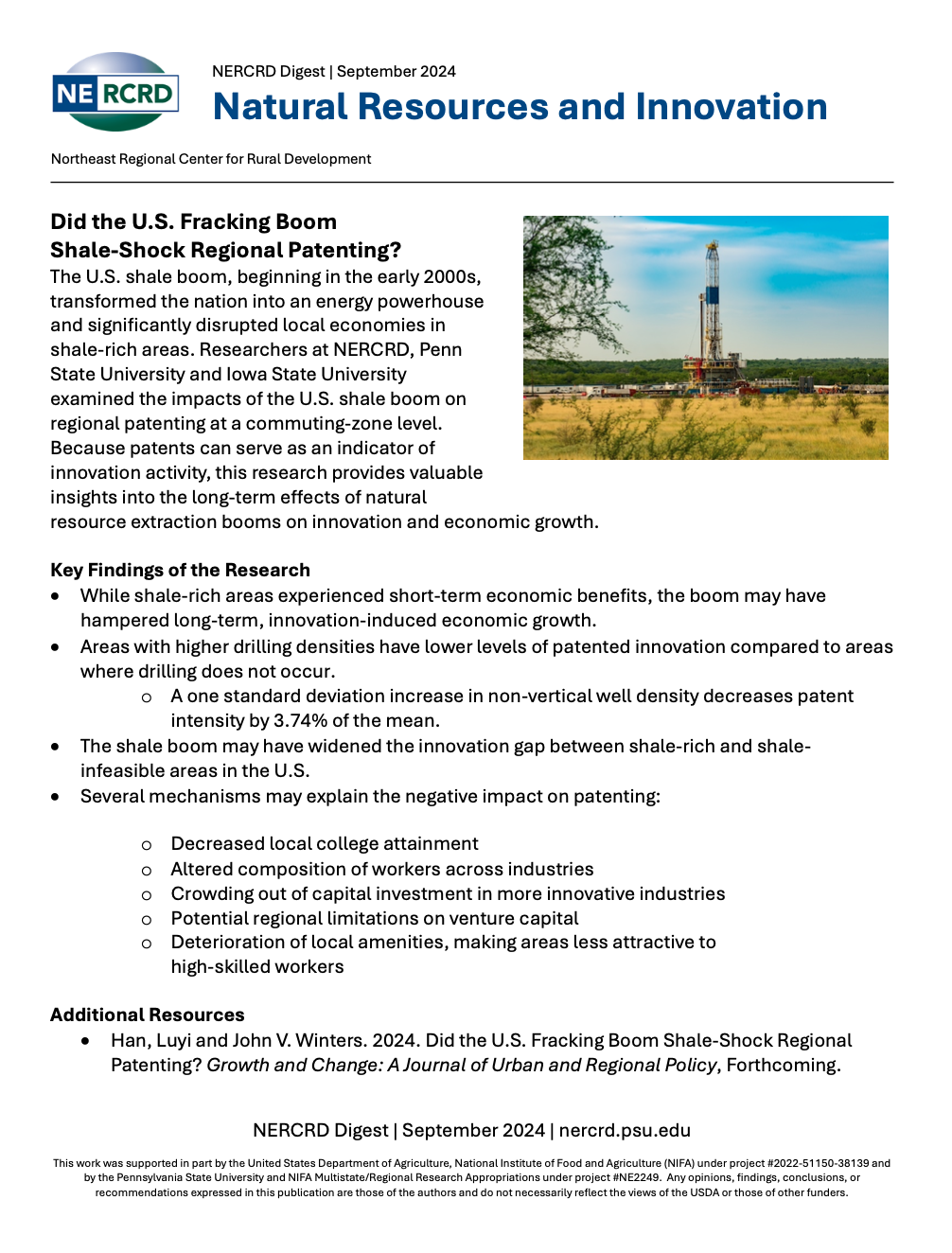Archive for Economic Development, Resilience, and Innovation
Minority-Owned Businesses: Insights from States in the Northeastern Region
This research report was developed as part of the USDA NIFA-funded project, “Factors Affecting the Success of Female and Minority Rural Entrepreneurs and Rural Economic Vitality.” The project, led by Dr. Heather M. Stephens, West Virginia University, seeks to provide insights into female and minority entrepreneurship to help key stakeholders develop policies and programs to support their success. This report provides detailed information about minority-owned businesses in the Northeast region. By highlighting the differences in minority entrepreneurship across the region, this report can support the development of policies to promote minority business development.
Authors: Xiaoyin Li, Heather M. Stephens, and Stephan J. Goetz
Publication: NERCRD Data Brief Date Published: October 22, 2024
The Complex Picture of Caregivers Health and Well-Being in the Northeast Region
This “Research Snapshot” explores the health and well-being of caregivers in the Northeast Region, as reported by households as part of the “NER-Stat: Caregiving Survey” — a regional household survey that the North Central Regional Center for Rural Development (NCRCRD) conducted in collaboration with Northeast Regional Center for Rural Development (NERCRD), The Ohio State University and the National Farm Medicine Center. The survey was conducted in 2023 with 4,480 responses from the 13 states of the Northeast Region through a Qualtrics online panel. Since the caregiving needs of children and adults vary, the researchers explored variations on supports used based on the type of care provided. The dataset that this brief draws upon is also available online here: https://purr.purdue.edu/publications/4491/1
To learn more about this research and to access other briefs in this caregiving series, click here.
To access the version of this brief that focuses on the North Central U.S. region, click here.
Authors: Elena Pojman, Florence Becot, and Shoshanah Inwood
Publication: NERCRD Research Brief Date Published: October 17, 2024
Tags: caregiving
What supports do caregivers in the Northeast use and what support do they still need?
This “Research Snapshot” explores the supports that caregivers use and the supports they still need, as reported by households as part of the “NER-Stat: Caregiving Survey” — a regional household survey that the North Central Regional Center for Rural Development (NCRCRD) conducted in collaboration with Northeast Regional Center for Rural Development (NERCRD), The Ohio State University and the National Farm Medicine Center. The survey was conducted in 2023 with 4,480 responses from the 13 states of the Northeast Region through a Qualtrics online panel. Since the caregiving needs of children and adults vary, the researchers explored variations on supports used based on the type of care provided. The dataset that this brief draws upon is also available online here: https://purr.purdue.edu/publications/4491/1
To learn more about this research and to access other briefs in this caregiving series, click here.
To access a version of this brief that focuses on the North Central U.S., click here.
Authors: Emily Southard, Florence Becot, Shoshanah Inwood
Publication: NERCRD Research Brief Date Published: October 9, 2024
Tags: caregiving, data brief
Insights and oversights: Behind the data on agritourism and direct sales in the United States
Abstract: Agritourism is growing worldwide as farmers and ranchers seek alternative sources of revenue, and consumer demand for agricultural experiences is on the rise. Understanding this sector is important for policymakers, researchers, agricultural service providers, and others seeking to support farm viability and rural entrepreneurship. However, in the U.S., this support is hampered by the lack of a clear definition and consistent, comprehensive means for measuring the agritourism sector. The best available data for the U.S. are from the quinquennial U.S. Department of Agriculture National Agricultural Statistics Service (USDA NASS)’s Census of Agriculture. However, the two questions used by the Census of Agriculture that relate to agritourism are worded in ways that limit a comprehensive understanding of the size and scope of the sector. To illustrate the limitations, we highlight cases from two U.S. states (Texas and Vermont), where different forms of agritourism are present. One such form, hunting, is included in the USDA’s economic assessments of agritourism; another, pick-your-own berries, is not. Along with tastings and purchases of locally grown products, this falls in the category of direct sales. The discrepancy can result in misrepresentation and misinterpretation of the data in analyses and subsequent publications with distorted policy recommendations related to agritourism. We discuss these cases alongside recommendations on how to more accurately measure, and support, agritourism development in the U.S.
Authors: Chadley R. Hollas, Claudia Schmidt, Zheng Tian, Stephan J. Goetz, and Lisa Chase
Publication: Journal of Agriculture, Food Systems, and Community Development Date Published: August 26, 2024
Tags: agritourism
Land-Grant University Capacity to Support Recreation Economies in National Forest Gateway Communities
This report was developed by Doug Arbogast, Rural Tourism Specialist, West Virginia University Extension Service, with support from the Extension Foundation, Regional Rural Development Centers (RRDCs), and the members of the National Extension Outdoor Recreation Working Group (NEORWG). It describes findings from an assessment conducted in 2024 of the capacity of Land Grant Universities to provide both Extension and research support for the development of recreation economies, and to determine the places in each RRDC region best positioned to deploy resources for program implementation. Arbogast’s analysis also includes two map resources:
- A data dashboard showing USDA RD investments already made in counties that contain a national forest.
- A map designed to identify opportunities for USDA Partnerships (Extension, Forest Service, and Rural Development) to support the development of recreation economies in gateway communities to U.S. National Forests. This map’s layers include Land Grant institutions that responded to the recreation economy survey, USDA Rural Development locations, USDA Forest Service locations, National Forest gateway communities, and regions served by the National Extension Tourism Network and the RRDCs.
Authors: Doug Arbogast, West Virginia University
Publication: Published by Extension Foundation and NERCRD Date Published: September 20, 2024
Tags: neorwg, NET, outdoor recreation
Did the U.S. Fracking Boom Shale-Shock Regional Patenting?
The shale boom of the early 21st century turned the U.S. into an energy powerhouse and significantly disrupted local economies with shale resources. This study examines the impacts of the U.S. shale boom on regional patenting at a commuting zone level. The shale boom may negatively affect patents if it crowds out labor and capital investments in other non-energy industries. Our findings show that a one standard deviation increase in non-vertical well density decreases patent intensity by 3.74% of the mean. Areas with higher drilling densities have lower levels of patented innovation compared to their counterfactuals. This paper contributes to the existing literature related to the “natural resource curse.” We provide new evidence based on regional patenting, which is an important indicator for regional innovation and long-term economic growth.
Authors: Luyi Han, John V. Winters
Publication: Growth and Change Date Published: September 17, 2024



